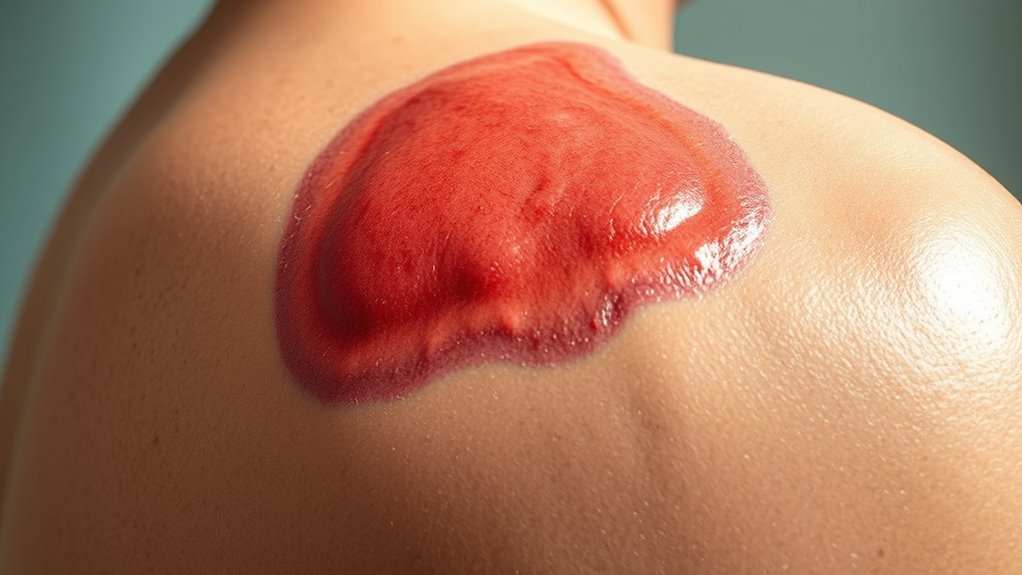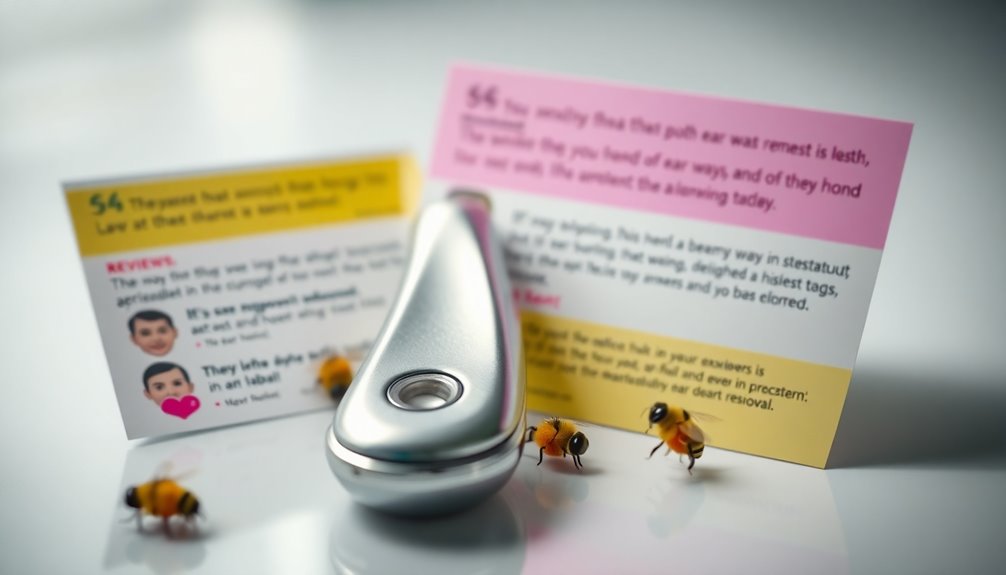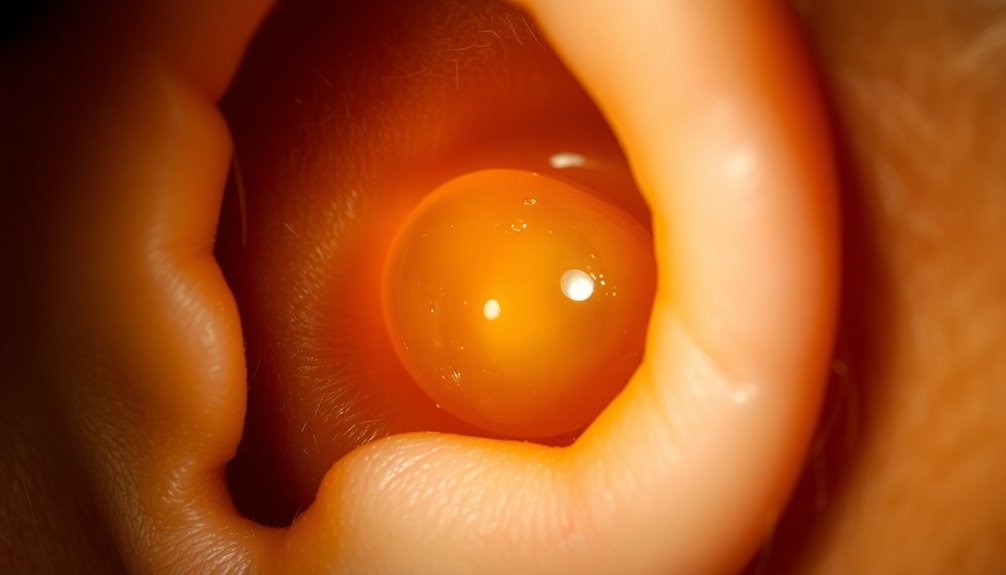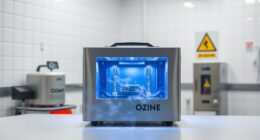Keloids happen because your skin produces too much collagen during healing, causing scars to grow beyond the original wound. Factors like genetics, skin type, and injury location influence whether you develop keloids. People with darker skin tones or a family history are more prone. The way your skin heals and triggers like trauma or infection also play a role. To understand how these factors cause some scars to grow, keep exploring the details below.
Key Takeaways
- Keloids form due to excess collagen production during healing, causing scars to grow beyond the original wound boundaries.
- Genetic factors and family history increase susceptibility to abnormal scar growth, including keloids.
- Darker skin tones and certain ethnicities are more prone to developing keloids because of higher collagen activity.
- Environmental triggers like skin infections, repeated trauma, or UV exposure can stimulate keloid formation.
- Variations in individual healing processes and immune responses influence whether a scar develops into a keloid.
Understanding the Nature of Keloids

Keloids are raised, thickened scars that form when your body overproduces collagen during the healing process. Instead of fading or settling down like normal scars, they continue to grow beyond the original wound boundaries. This excess collagen creates a firm, rubbery texture that can be shiny or smooth. They often develop after skin injuries such as cuts, piercings, or burns, but sometimes appear without any clear trigger. Keloids tend to be more common in darker-skinned individuals and can vary in size, shape, and color. While they’re not usually painful, they can cause itching or discomfort. Understanding their nature helps you recognize why some scars become problematic and highlights the importance of proper wound care to minimize their formation. Additionally, research into sound healing science suggests that some therapies may help manage skin conditions and improve healing processes.
The Role of Genetics in Keloid Development
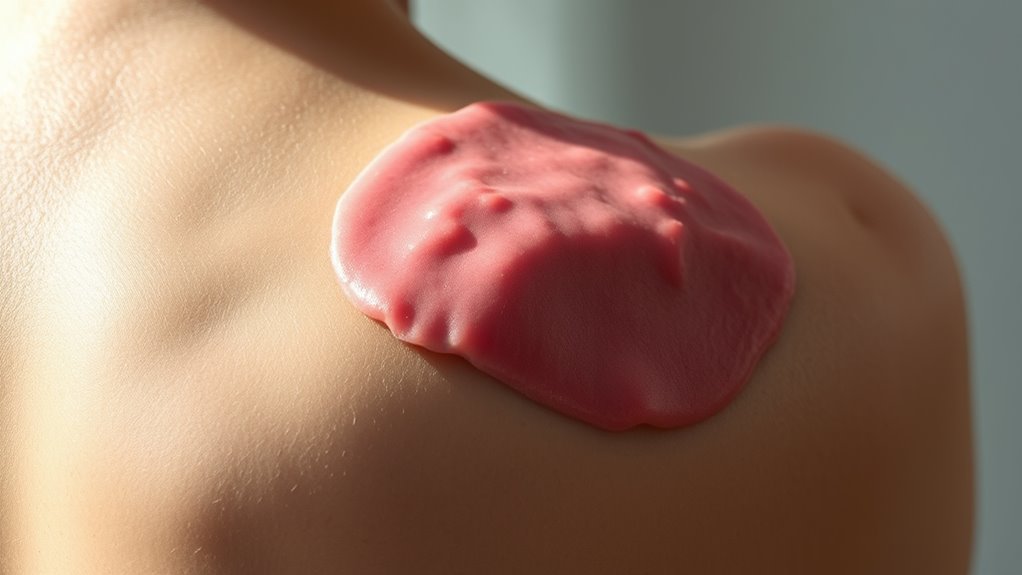
You might notice that some people are more prone to keloids than others, suggesting genetics play a role. Family history often influences who develops these scars, indicating a hereditary factor. Variations in skin-related genes can also affect your risk, making genetics a key piece of the puzzle.
Genetic Predisposition Factors
Genetics play a significant role in determining an individual’s likelihood of developing keloids, as research shows that these scars often run in families. If your relatives have experienced prominent or raised scars, you may have a higher risk of developing keloids yourself. Specific gene variations influence how your skin heals, affecting collagen production and scar formation. Understanding these genetic factors helps explain why some people are more prone to keloids than others.
| Genetic Factors | Impact on Keloid Formation |
|---|---|
| Family history | Higher risk if relatives have keloids |
| Collagen gene mutations | Altered healing and scar tissue growth |
| Ethnic background | Increased prevalence in certain groups |
| Immune response genes | Influences scar severity and growth |
Family History Influence
Family history plays a crucial role in determining your risk of developing keloids, as research shows these scars tend to run in families. If your relatives have keloids, you’re more likely to develop them yourself, indicating a strong genetic component. This pattern suggests that inherited traits influence how your skin responds to injury, leading to excessive collagen production. Knowing your family history can help you assess your risk and take proactive steps, like avoiding unnecessary skin trauma or seeking early treatment for wounds. While genetics isn’t the sole factor, understanding your family’s history provides valuable insight into your susceptibility. If keloids are common in your family, discussing this with a dermatologist can guide personalized prevention and management strategies.
Variations in Skin Genes
Variations in specific skin genes can considerably influence the likelihood of developing keloids. Your genetic makeup affects how your skin responds to injury, especially how it heals and forms scar tissue. Certain gene variants can lead to overproduction of collagen, which causes the excessive growth characteristic of keloids. Researchers have identified genes related to skin elasticity, inflammation, and wound healing that play roles in keloid development. If you carry these genetic variations, you’re more prone to developing keloids after skin injuries or surgeries. Knowing about your genetic predisposition can help you and your healthcare provider manage scars more effectively. Additionally, understanding the role of collagen can provide insight into why some scars become keloids while others do not. While genes aren’t the only factor, they substantially contribute to why some people develop prominent keloids while others heal with minimal scarring.
Skin Types and Their Influence on Scarring

Your skin type plays a significant role in how scars develop and heal. Some skin types are more prone to keloids, while others tend to heal with minimal scarring. Understanding these differences helps you better manage and prevent excessive scarring. Additionally, research into AI safety measures highlights the importance of monitoring and addressing vulnerabilities that could impact medical applications, including scar treatment strategies.
Skin Type Susceptibility
Have you ever wondered why some people develop prominent keloids while others heal with minimal scarring? Your skin type plays a significant role in this. People with darker skin tones, such as African, Asian, or Hispanic backgrounds, are more prone to keloid formation. Thicker, more active collagen production can lead to exaggerated scar tissue. Some skin types also have a higher tendency for inflammation, which fuels keloid growth. Additionally, skin that’s more elastic or prone to stretching can increase susceptibility. The following factors influence your risk:
- Darker pigmentation
- Thicker dermal layers
- Increased collagen activity
- Tendency to develop hypertrophic scars
- Skin prone to inflammation
- Home furnishings can impact skin health by affecting sleep quality and overall comfort, indirectly influencing healing processes.
Understanding your skin type helps you anticipate your scarring risk and seek tailored treatments.
Healing Variations Among Skin
Different skin types respond uniquely during the healing process, influencing how scars form and evolve. If you have darker skin, your body produces more melanin, which can lead to a higher risk of keloid formation. On the other hand, lighter skin tends to heal with less noticeable scarring, but it doesn’t mean you’re immune. Your skin’s thickness, collagen levels, and elasticity also play vital roles. Thicker or more elastic skin may recover quickly but can sometimes produce excess collagen, increasing keloid chances. Conversely, fragile or thin skin might heal with minimal scarring but is more prone to tearing or infection. Understanding your skin type helps you anticipate your healing pattern and seek tailored treatments to minimize abnormal scars. Additionally, inflammatory responses during healing can influence the likelihood of scar hypertrophy or keloid development.
The Healing Process and Scar Formation
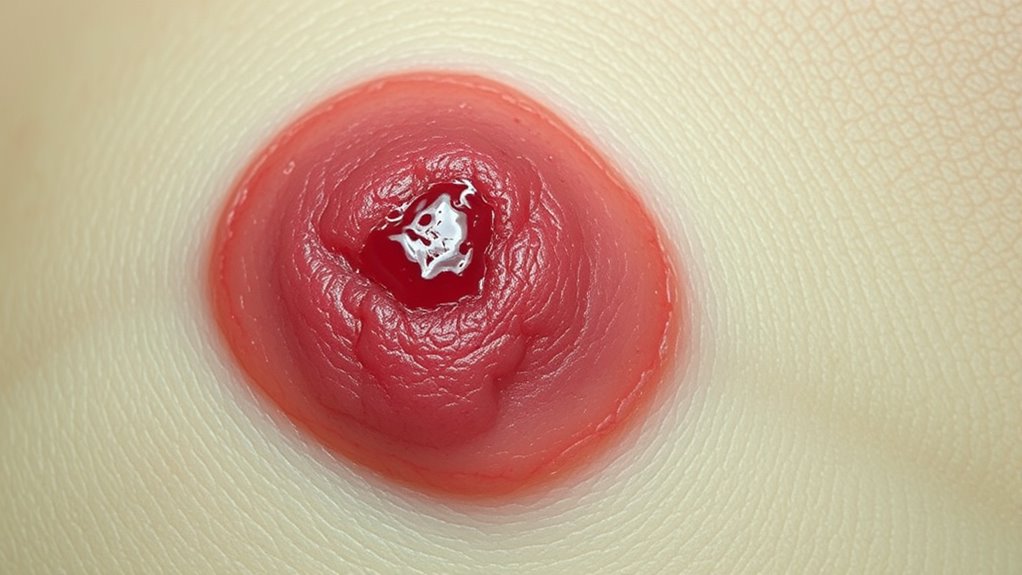
When the skin sustains an injury, the body initiates a complex healing process that leads to scar formation. First, blood clots form to stop bleeding, providing a temporary barrier. Then, your body sends new cells to replace damaged tissue, including collagen, which gives strength and structure. As healing continues, new blood vessels develop to nourish the area. Over time, your body remodels the tissue, tightening and reshaping the scar. To imagine this, picture this:
- Blood clot creating a protective plug
- Influx of immune cells clearing debris
- Fibroblasts producing collagen fibers
- Formation of new blood vessels
- Remodeling phase with collagen realignment
In the process, blood flow plays a crucial role in delivering nutrients and oxygen necessary for tissue repair. This orchestrated process results in a scar, which varies based on genetic and environmental factors. Understanding this helps explain why some scars grow excessively, leading to keloids.
Triggers That May Promote Keloid Growth

Certain factors can trigger or accelerate keloid growth, making some individuals more prone to developing large, raised scars. For example, skin injuries like cuts, piercings, or burns often serve as starting points. If your skin heals quickly or overproduces collagen, the risk increases. Additionally, certain body areas, such as the chest, shoulders, and earlobes, are more susceptible. You may also notice that infections or repeated trauma at a wound site stimulate keloid formation. Age and genetic predisposition play roles, too: younger skin and a family history of keloids heighten your chances. Environmental factors, like UV exposure, can also influence growth. Recognizing these triggers helps you understand why some scars become keloids while others do not. High collagen production is a key factor in the development of keloids, as it leads to excessive scar tissue formation beyond the original wound.
Differentiating Keloids From Hypertrophic Scars

While triggers like skin injury and genetic factors can lead to keloid formation, it’s important to recognize how these scars differ from hypertrophic scars. Keloids extend beyond the original wound, growing into healthy skin, while hypertrophic scars stay within the wound boundary. Keloids tend to be firm, shiny, and irregular in shape, often appearing months after injury. In contrast, hypertrophic scars usually appear within weeks and may flatten or improve over time. They also differ in color; keloids are often darker or redder, whereas hypertrophic scars are usually pink or red. Additionally, vetted products and treatments can help manage or prevent keloid growths.
Treatment Options and Management Strategies
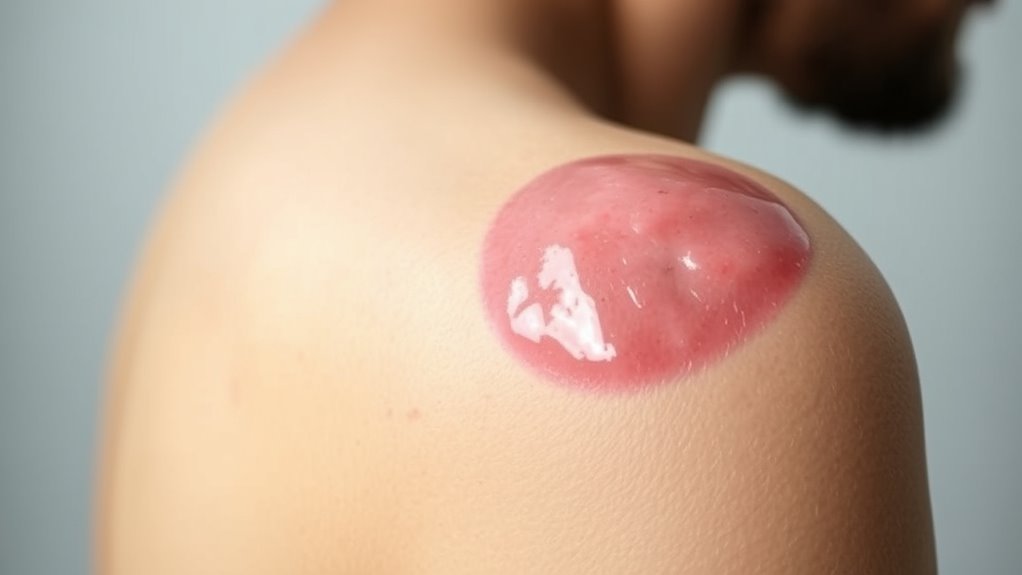
Effective management of keloids involves a combination of treatments tailored to your specific condition. Corticosteroid injections are commonly used to reduce inflammation and flatten the scar. Silicone gel sheets or silicone-based products can help soften and minimize keloids over time. In some cases, your healthcare provider might recommend cryotherapy, freezing the keloid to shrink it. Laser therapy can also improve the scar’s appearance by targeting blood vessels and reducing redness. If other methods fail, surgical removal may be considered, often combined with corticosteroids to prevent recurrence. It is crucial to follow your treatment plan closely, avoid unnecessary trauma to the area, and protect the scar from sun exposure. These strategies aim to improve both the appearance and comfort of your keloid. Incorporating proper skin care practices can also support healing and reduce the likelihood of further scar development.
Ongoing Research and Future Perspectives
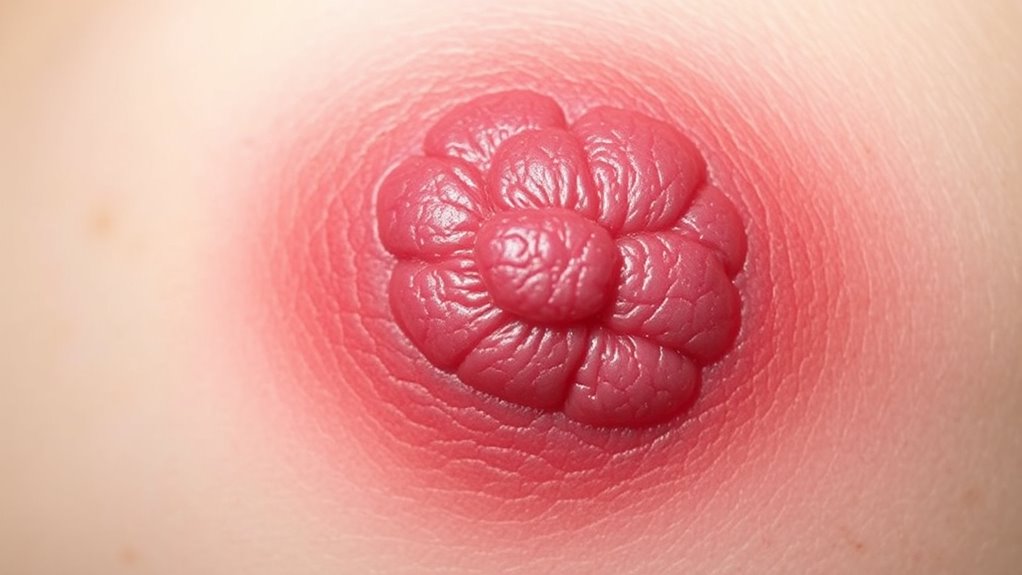
Research into keloid treatments is advancing rapidly, promising new options that could improve outcomes. Scientists are exploring innovative approaches, such as targeted gene therapy, advanced drug delivery systems, and regenerative techniques. These developments aim to address the root causes of keloid formation and reduce recurrence rates. Future therapies might include personalized treatments based on genetic profiles and immune system modulation. Additionally, researchers are investigating the role of stem cells and bioprinting to develop more effective, skin-like replacements. Promising clinical trials are underway, offering hope for more effective, less invasive options. Advances in precision medicine tailored to individual genetics and novel delivery methods for existing treatments are also being developed to enhance efficacy and reduce side effects.
Frequently Asked Questions
Can Keloids Develop Years After the Initial Injury?
You might wonder if keloids can develop years after an injury. The answer is yes; they can. Keloids often appear months or even years after the initial wound, especially if your skin continues to heal and remodel over time. Factors like skin tension, genetics, and ongoing inflammation can trigger their growth long after the original injury. So, it’s possible for a keloid to develop well after you thought the wound had healed.
Are There Specific Foods That Worsen Keloid Formation?
Imagine certain foods acting like fuel for scar tissue, making your keloids worse. Some people believe salty, sugary, or processed foods can promote inflammation and collagen overproduction, potentially worsening keloids. While research isn’t conclusive, eating anti-inflammatory foods like fruits, vegetables, and omega-3-rich fish might help. You should avoid excessive salt and processed snacks to give your skin the best chance to heal without excess scar growth.
How Do Age and Gender Influence Keloid Growth?
Age and gender can influence how your scars develop. Younger individuals tend to have more active healing processes, which might increase keloid growth risk. Women, especially during hormonal changes like pregnancy, may experience more active scar formation due to hormonal effects on skin. You should pay close attention to your skin’s healing, as these factors can increase the likelihood of keloids forming or enlarging.
Do Keloids Pose Any Health Risks Beyond Cosmetic Concerns?
Did you know that about 15% of people with keloids experience itching, pain, or tenderness? Beyond cosmetic issues, keloids can sometimes cause discomfort, restrict movement if they form over joints, or lead to skin infections if scratched or irritated. While rare, large or rapidly growing keloids may also signal underlying skin changes, making it important to monitor them and seek medical advice if symptoms worsen or new symptoms appear.
Can Physical Activity or Clothing Affect Keloid Development?
Physical activity and clothing can influence keloid development. Tight or restrictive clothing may irritate the scar, causing it to grow larger. Excessive or vigorous exercise might also put strain on healing skin, increasing the risk of keloid formation. To minimize chances, wear loose, breathable clothes and avoid activities that cause friction or pulling on your scars. Staying gentle with your skin helps prevent keloids from worsening or forming.
Conclusion
Think of your skin as a garden, where scars are seeds. Sometimes, these seeds grow into wild, towering plants called keloids, overshadowing the gentle blooms of healing. By understanding what stokes their growth—your genetics, skin type, and triggers—you can tend your garden more wisely. With proper care and awareness, you can prevent these unwanted plants from taking over, allowing your skin to flourish naturally and beautifully, like a well-tended, harmonious landscape.
